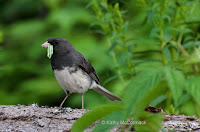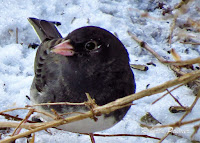DARK-EYED JUNCO
DARK-EYED JUNCO (Junco hyemalis) – (See images below)
DESCRIPTION: The Dark-eyed Junco male is dark grey with a white belly. It has white outer tail feathers, visible in flight. The breast is also grey. The bill is pinkish and the legs are grey. The eyes are black (as the name implies). The female has less marked colors. The bird is about 15 cm (6 inches) long. (There are several subspecies with different plumages.)
VOICE: https://www.xeno-canto.org/species/Junco-hyemalis
NAME: The English name ‘Junco’ derives from Latin ‘Juncus’, which means ‘rush’. However reeds are not part of this bird’s habitat. As for the Latin species name ‘hyemalis’, which means ‘winter’, this is because the first individual was identified in its winter habitat.
HABITAT: Forested areas (notably with conifers) in the summer, urban areas, fields, open woodlands in the winter.
DIET: This bird has a seed eater bill, but it will also eat insects. The dark-eyed junco is a frequent visitor around bird feeders (see video below). It is a ground feeder.
NESTING: These juncos build their nests in a shallow depression on the ground, in a well-hidden area. An average of four light grey eggs are laid, which are incubated by the female. Both parents feed the chicks.
DISTRIBUTION: The dark-eyed junco is a North-American species that breeds in most of Canada except in the tundra. They are found year-round in the southeast part of that country and also west of the Rockies. They are year-round residents of northeast and western USA. Wintering populations are found in the rest of the USA and northern Mexico.
DISTRIBUTION MAP: https://en.wikipedia.org/wiki/Dark-eyed_junco#/media/File:Dark-eyed_Junco-rangemap.png
ON PEI: The dark-eyed junco is a year-round resident on Prince Edward Island, and is very common.
CONSERVATION: Although there has been some decline in the overall population of this species, they still number in the 200,000,000 range, so are not considered at risk.
NOTES: The dark-eyed junco is part of the large sparrow family, and can often be observed foraging on the ground with other sparrows, such as the White-throated Sparrow. It eats the sunflower seed by crushing them in its bill, whereas the Black-capped Chickadee and the Blue Jay hold the seed between their toes and peck at it to get the kernel.
SIMILAR SPECIES: Spotted Towhee
REFERENCES: https://www.mba-aom.ca/jsp/toc.jsp (Maritimes Breeding Birds Atlas)
American Bird Conservancy (Dark-eyed Junco)
https://www.borealbirds.org/bird/dark-eyed-junco
https://en.wikipedia.org/wiki/Dark-eyed_junco
https://www.audubon.org/field-guide/bird/dark-eyed-junco
https://www.allaboutbirds.org/guide/Dark-eyed_Junco/id
https://nature.mdc.mo.gov/discover-nature/field-guide/dark-eyed-junco (Missouri Department of Conservation)
This video below shows how the dark-eyed junco ‘chews’ the sunflower seeds to break the shell and get the kernel:
DESCRIPTION: The Dark-eyed Junco male is dark grey with a white belly. It has white outer tail feathers, visible in flight. The breast is also grey. The bill is pinkish and the legs are grey. The eyes are black (as the name implies). The female has less marked colors. The bird is about 15 cm (6 inches) long. (There are several subspecies with different plumages.)
VOICE: https://www.xeno-canto.org/species/Junco-hyemalis
NAME: The English name ‘Junco’ derives from Latin ‘Juncus’, which means ‘rush’. However reeds are not part of this bird’s habitat. As for the Latin species name ‘hyemalis’, which means ‘winter’, this is because the first individual was identified in its winter habitat.
HABITAT: Forested areas (notably with conifers) in the summer, urban areas, fields, open woodlands in the winter.
DIET: This bird has a seed eater bill, but it will also eat insects. The dark-eyed junco is a frequent visitor around bird feeders (see video below). It is a ground feeder.
NESTING: These juncos build their nests in a shallow depression on the ground, in a well-hidden area. An average of four light grey eggs are laid, which are incubated by the female. Both parents feed the chicks.
DISTRIBUTION: The dark-eyed junco is a North-American species that breeds in most of Canada except in the tundra. They are found year-round in the southeast part of that country and also west of the Rockies. They are year-round residents of northeast and western USA. Wintering populations are found in the rest of the USA and northern Mexico.
DISTRIBUTION MAP: https://en.wikipedia.org/wiki/Dark-eyed_junco#/media/File:Dark-eyed_Junco-rangemap.png
ON PEI: The dark-eyed junco is a year-round resident on Prince Edward Island, and is very common.
CONSERVATION: Although there has been some decline in the overall population of this species, they still number in the 200,000,000 range, so are not considered at risk.
NOTES: The dark-eyed junco is part of the large sparrow family, and can often be observed foraging on the ground with other sparrows, such as the White-throated Sparrow. It eats the sunflower seed by crushing them in its bill, whereas the Black-capped Chickadee and the Blue Jay hold the seed between their toes and peck at it to get the kernel.
SIMILAR SPECIES: Spotted Towhee
REFERENCES: https://www.mba-aom.ca/jsp/toc.jsp (Maritimes Breeding Birds Atlas)
American Bird Conservancy (Dark-eyed Junco)
https://www.borealbirds.org/bird/dark-eyed-junco
https://en.wikipedia.org/wiki/Dark-eyed_junco
https://www.audubon.org/field-guide/bird/dark-eyed-junco
https://www.allaboutbirds.org/guide/Dark-eyed_Junco/id
https://nature.mdc.mo.gov/discover-nature/field-guide/dark-eyed-junco (Missouri Department of Conservation)
 |
| Dark-eyed junco male, Kathy McCormack |
 |
| Dark-eyed junco male with caterpillars by Kathy McCormack |
 |
| Dark-eyed junco male, Roberta Palmer |
 |
| Dark-eyed junco female, QC, by Cephas |
This video below shows how the dark-eyed junco ‘chews’ the sunflower seeds to break the shell and get the kernel: